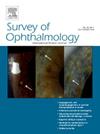Presumed phototoxicity from macular vital staining with Brilliant Blue G and Trypan Blue: A post-market surveillance study, systematic review, and synthesis of the literature
IF 5.9
2区 医学
Q1 OPHTHALMOLOGY
引用次数: 0
Abstract
Vital dyes are used to help visualize the retinal surface during macular surgery; however, they have been associated with phototoxicity. We synthesize and collate post-market surveillance data in two of the most commonly used dyes, Brilliant Blue G and Trypan Blue. We identified 69 cases, 59 of which were from the literature and 10 from manufacturer post-market surveillance. Of 69 vitrectomies, 39 were for macular hole, 24 for epiretinal membrane, 2 for vitreomacular traction, and 4 were not specified. The incidence of dye-mediated phototoxicity is likely rare, but is not possible to quantify, due to potential reporting and publication bias favouring dissemination of unusual safety events, but conversely underreporting is possible. Additionally, phototoxicity was reported prior to the introduction of vital stains, so it can be difficult to establish whether vital staining was contributory. Prolonged surgery and repeat staining were identified as risk factors. Characteristic clinical features were macular pigmentary change with hypo- and hyper-autofluoresence, often sparing the fovea. Final visual acuity tended to be worse than preoperatively, with some cases reduced to counting fingers. A reporting template is provided to encourage complete and standardised toxicity reporting and help build a robust evidence base.
用亮蓝 G 和胰蓝对黄斑要害染色推测的光毒性:一项上市后监测研究、系统回顾和文献综述。
在黄斑手术中,生命染料被用来帮助观察视网膜表面,但它们与光毒性有关。本文献综述和上市后监测数据整理考虑了两种最常用的染料--亮蓝 G 和胰蓝。我们发现了 69 例病例,其中 59 例来自文献,10 例来自制造商的上市后监测。在 69 例玻璃体切除术中,39 例是由于黄斑孔,24 例是由于视网膜外膜,2 例是由于玻璃体粘膜牵引,4 例未作说明。染料介导的光毒性发生率可能非常罕见,但由于潜在的报告和发表偏差有利于异常安全事件的传播,因此无法量化,但反之也可能存在报告不足的情况。此外,光毒性是在引入活力染色之前报告的,因此很难确定活力染色是否是造成光毒性的原因。延长手术时间和重复染色被认为是风险因素。典型的临床特征是黄斑色素改变,伴有低自荧光和高自荧光,通常不影响眼窝。最终视力往往不如术前,有些病例甚至只能数手指。本报告提供了一个报告模板,以鼓励完整、标准化的毒性报告,并帮助建立健全的证据基础。
本文章由计算机程序翻译,如有差异,请以英文原文为准。
求助全文
约1分钟内获得全文
求助全文
来源期刊

Survey of ophthalmology
医学-眼科学
CiteScore
10.30
自引率
2.00%
发文量
138
审稿时长
14.8 weeks
期刊介绍:
Survey of Ophthalmology is a clinically oriented review journal designed to keep ophthalmologists up to date. Comprehensive major review articles, written by experts and stringently refereed, integrate the literature on subjects selected for their clinical importance. Survey also includes feature articles, section reviews, book reviews, and abstracts.
 求助内容:
求助内容: 应助结果提醒方式:
应助结果提醒方式:


